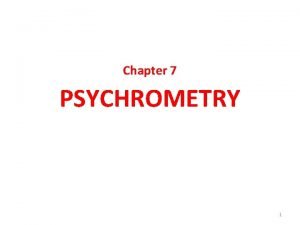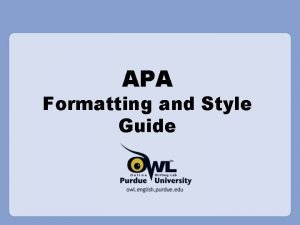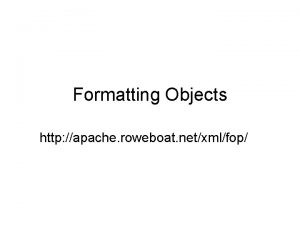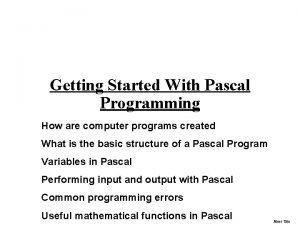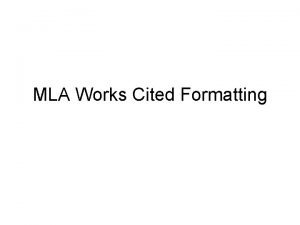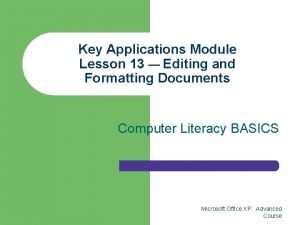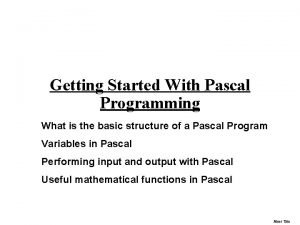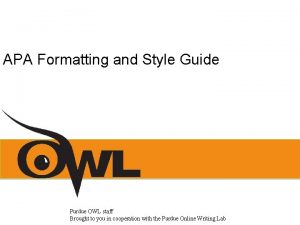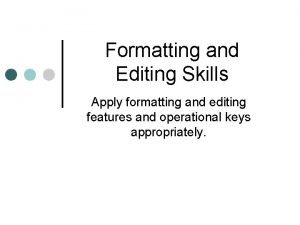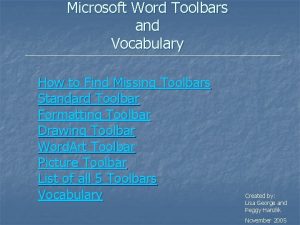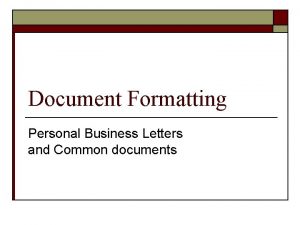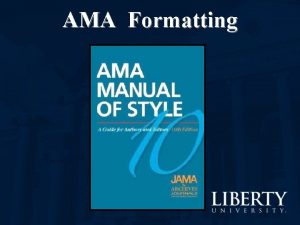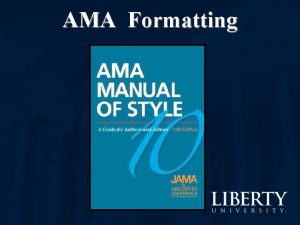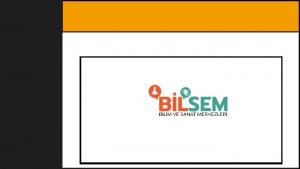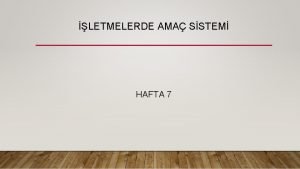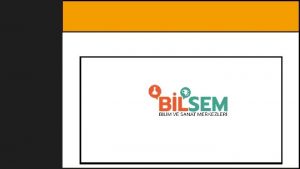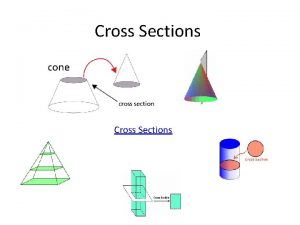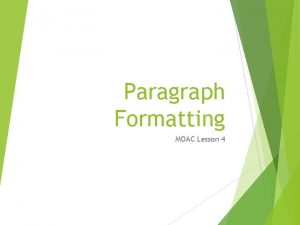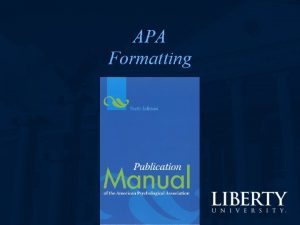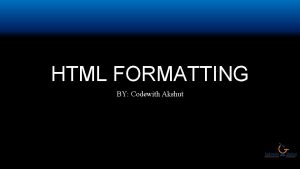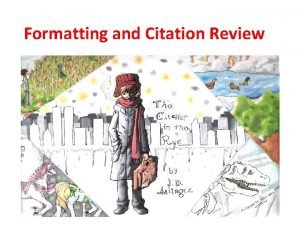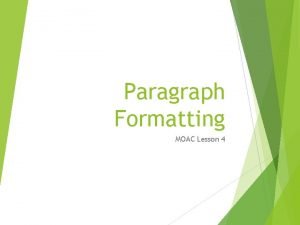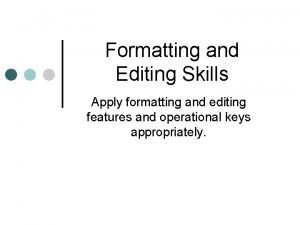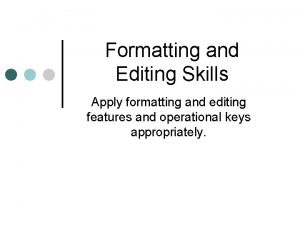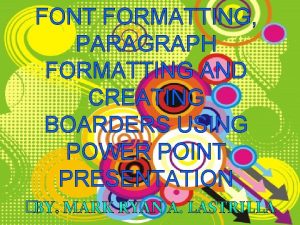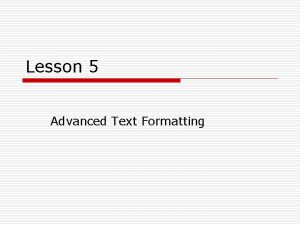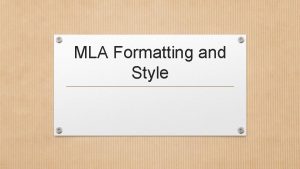AMA Formatting Cliffnotes Patrick Cross PT DPT RHF


























- Slides: 26

AMA Formatting “Cliffnotes” Patrick Cross, PT, DPT, RHF

Reference Citation in Paragraphs • Site frequently vs. infrequently • Avoid secondary citations if possible – See AMA 3. 10 [10 th ed] • References are in order of use throughout the paper – End. Note is a program that may be a beneficial tool • Note that it is not perfect and one needs to edit references before submitting

Reference Citation in Paragraphs • If whole paragraph from same source, site first and last sentences • When changing citations, site the last sentence by one author. X – Then site the first sentence by the next author. Y • Citations come after the comma or period. Z • Citations come before the colon or semicolon. A;

Reference Citation in Paragraphs • Don’t use the author’s first name, just use the last name • If one author, just state the last name when refer to the study – In the study by Karges, # • If two authors, state both names – In the study by Cross and Berg, # • If three or more authors, state the last name of the first author and then et al, and colleagues, etc. – Svien et al# • It is best to site right after the name rather than the end of the sentence. – Osborn and colleagues. B found…

Direct Quotes • Use as few direct quotes as possible • Use quotation marks to enclose a direct quote of no more than 4 typewritten lines (run-on quote) – May be more than 4 lines if enclosing conversational dialogue (see AMA page 359 [10 th ed]) • Direct quotes need a page number with each citation… – “Using a sample of convenience, 14 women were selected in a consecutive manner to participate in the study at a clinic that participates in women’s health. ” 1(p 138)

Direct Quotes • Follow wording, spelling, and punctuation of the original quote exactly – Do not omit citations embedded within original material quoting, but do not include them in the list of references – If omit text from a quotation, use ellipsis points • Three periods with a single space, before, between, and after each period • If between sentences use period to end sentence plus the 3 ellipsis points • Not used when opening of a sentence or end of a sentence is being omitted for a run-on quote – If block quote and initial words of first sentence are being omitted, begin with a paragraph indention and 3 ellipsis dots

Direct Quotes • Quotes greater than 4 typewritten lines have to be in a block format: (see AMA page 361 [10 th ed]) – Reduced type – No quotation marks – Indented on the left margin (1/2 inch or same distance as paragraph indent) • Only add another paragraph indent to the first line of text if it is found in the original – Single spaced for research papers, but may be double spaced in manuscripts submitted for publication – Set off from the text by additional spacing above and below the block

Numbers and Abbreviations • Write out numbers that begin a sentence unless it begins with a year – Regarding numbers, see AMA Chapter 18 and 19. 2. 1 [10 th ed] • Avoid starting sentences with abbreviations/ acronyms like COPD, PT, etc. • All state abbreviations are the same as postal abbreviations – Use state abbreviation in references – State has to be written out in the text – See AMA page 451 [10 th ed]

Numbers and Abbreviations • Write out unless used more than five times in an article or a familiar acronym – Expanded the first time with abbreviation following in parentheses • Physical therapists (PTs) • Write plurals without an apostrophe – PTs, not PT’s • Rarely periods (DPT, not D. P. T. unless quoted from another source)

Numbers and Abbreviations – Abbreviate names of journals in reference list according to Pub. Med Journals database • See AMA 3. 11. 2 [10 th ed] and 14. 10 • Other helpful sites: – Journal Abbreviations and List of Serials Indexed for Online Users from the National Library of Medicine

Writing Hints • Avoid 1 and 2 sentence paragraphs, but don’t have paragraphs that are 2 pages in length either • When reporting on studies that others have done, past tense is preferred – However, present tense may by used to “express a general truth, a statement of fact, something continually true. ” 2(p 320) • See AMA Pages 320 -321 [10 th ed]

Writing Hints • Try not to say “the study found, ” the “article suggested, ” etc. – Instead, state that “results indicated” or the “authors suggested” • Try not to make a general comment about “many studies” and then only cite one or two references – If refer to “several studies, ” then should cite several studies • When listing numerous studies, and first time presenting in paper, then place in order they appear next in paper. – If do not appear again, then ABC order by last name of primary author

Writing Hints • Avoid non-parallel lists – …collecting information, data analysis, and a summary of the results not good – …collecting information, analyzing data, summarizing results better • Avoid the passive voice – Data were collected from 300 patients by the student researchers. avoid – Student researchers collected data from 300 patients. better – See AMA page 320 [10 th ed]

Writing Hints • Avoid misplaced modifiers – The patient was referred to the physical therapist with an ACL injury. who has the ACL injury, the patient or the PT? – The patient with the ACL injury was referred to the physical therapist. – See AMA pages 322 -323 [10 th ed] • Subject verb agreement is important – AMA Section 7. 8 [10 th ed]

Writing Hints • Avoid subjects that require the use of singular pronouns if possible – What we typically see written is “The student worked on their assignment” incorrect – The student worked on his/her assignment correct, but harder to read. – The students worked on their assignment better to use plural if one can

Headings TYPICAL LEVEL ONE HEADING Typical Level Two Heading Typical level three heading. Then the paragraph wraps back to the left margin….

Reference Page • References start on a new page • Reference page comes before tables, figures and appendices • Typically single spaced – May be double spaced in manuscripts submitted for publication • References are numbered in the order they appeared in the text – See slide #12 regarding numerous references • No commas after the last names of the authors – Cross, PS incorrect – Cross PS correct • If >6 authors, list first 3 then “, et al. ” – See AMA 3. 7 [10 th ed]

Reference Page • Period after each section of the reference citation – Author(s). Article title. Journal Name. Year; volume(issue): page numbers. • Article title has only the first word capitalized unless there are proper nouns, etc. – If there is a colon, the first word after the colon is not capitalized • Use the appropriate journal abbreviations – Journal title is italicized • No space after semi-colon and colon for the year, volume(issue) and page numbers – 2005; 3(2): 123 -133 • Remove hyperlinks from Web site/ page addresses – Note “Web” is capitalized, with space between Web and site, but site or page not capitalized

Reference Page • The citations for books (3. 12. 2 and 3. 12. 4), Web sites (3. 15. 3), online journals (3. 15. 1), etc. is all different than for journal articles – Do not reference an entire book unless using “entire book” reference a chapter in a book – Use the AMA Chapter 3 [10 th ed]!

Basic Reference Examples 1. Karges JR, Mark BE, Stikeleather SJ, Worrell TW. Concurrent validity of upper-extremity volume estimates: comparison of calculated volume derived from girth measurements and water displacement volume. Phys Ther. 2003; 83(2): 134 -145. – Journal article <6 authors 2. Cameron MH. Physical Agents in Rehabilitation: From Research to Practice. 3 rd ed. Philadelphia, PA: W. B. Saunders; 2008. – Entire book

Basic Reference Examples 3. Cochran TM, Cross PS. American Indian culture. In: Black JD, Purnell LD, eds. Developing Cultural Competence in Physical Therapy Practice. Philadelphia, PA: F. A. Davis; 2005: 238 -259. – Chapter in a book with editors

Basic Reference Examples 4. Ekstrum J, Cross P, Sheridan S, Voltz JD. The last buffalo hunt: designing and implementing a culturally and community-driven model for health and wellness in an American Indian community. Paper presented at: The National Rural Health Association 13 th Annual Rural and Minority and Multicultural Health Conference: Traditional Health Customs and Practices: In Our Own Words; May 15, 2007; Anchorage, AK. – Presentation at a meeting, but not published

Basic Reference Examples 5. American Physical Therapy Association. Physical fitness for special populations. American Physical Therapy Association Web site. http: //www. apta. org/AM/Template. cfm? Section =Physical_Fitness_for_Special_Populations 1&Te mplate=/Tagged. Page. Display. cfm& TPLID=267&Content. ID=30270. Updated September 24, 2007. Accessed July 28, 2008. – Some my argue that no author given, but I would argue that it came from the organization so APTA is the author.

Tables • See examples regarding spacing, alignment, etc.

Other Resources • http: //www. docstyles. com/amaguide. htm

Search for the answer to the unknown in the AMA book and/or appropriate Web sites, ask for assistance from writing center and/or instructors WHAT I TELL MY STUDENTS: IGNORANCE IS NOT AN ACCEPTABLE EXCUSE
 Gimic program
Gimic program Animal farm chapter 10
Animal farm chapter 10 The psychrometry is study of
The psychrometry is study of Dpt 110
Dpt 110 Vcu dpt
Vcu dpt Dpt 110
Dpt 110 Dpt test procedure
Dpt test procedure Dpt psychology
Dpt psychology Dpt psychology
Dpt psychology What is apa formatting style
What is apa formatting style Apache fop
Apache fop Formatting toolbar
Formatting toolbar Sqlplus report formatting
Sqlplus report formatting Gambar toolbar formatting
Gambar toolbar formatting Pascal algorithm examples
Pascal algorithm examples Owl mla works cited
Owl mla works cited Paragraph formatting
Paragraph formatting Which hidden formatting symbol represents a tab character
Which hidden formatting symbol represents a tab character Weather in excel
Weather in excel Pascal writeln format
Pascal writeln format Interface ms word
Interface ms word Apa owl purdue
Apa owl purdue Magnetic read and write mechanisms
Magnetic read and write mechanisms Formatting skills
Formatting skills Word standard toolbar
Word standard toolbar Personal business letter format
Personal business letter format Punctuation marks quotes
Punctuation marks quotes


